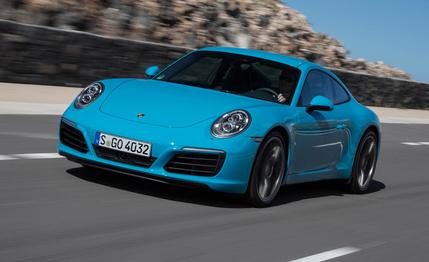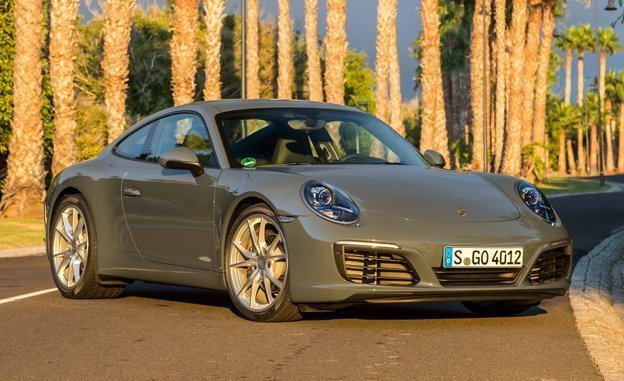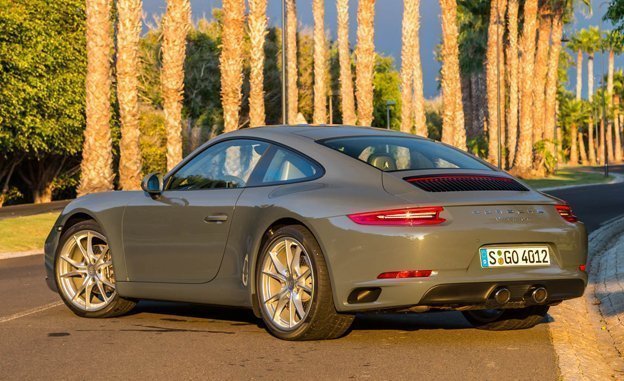
 First Drive Review
First Drive Review
The big news out of Stuttgart for 2017 is that the 911 Carrera and Carrera S are now turbocharged. That’s right, turbos aren’t just for 911 Turbos anymore.
Both the Carrera and the Carrera S get two turbochargers hitched to a 3.0-liter flat-six that is smaller in displacement than last year’s naturally aspirated engines. Buying a Porsche turbo is now easier but not easy: You’ll still have to get over the Carrera’s $90,395 point of entry.
Turbocharged 911s have existed for 40 years, but putting a turbo in a regular 911 is met with suspicion among fans of the crisp response of Porsche’s naturally aspirated engines. “Turbos are for Turbos,” they’ll chant. Confusion will follow, chaos will reign.
So, what’s the big deal about turbos? After all, turbos gave the Porsche 959 superpowers, put the Lotus Esprit in Bond movies, and made the Buick GNX a blue-collar dream machine. Turbos are magical little snail shells of power, but they imbue engines with a different feel than naturally aspirated engines. Turbos need to build pressure to provide power and consequently there can be a bit of a wait for full thrust. Old 911 Turbos really made you wait, and then they hit with the subtlety of a three wood.


But Porsche has been battling turbo lag and working to smooth out the hit longer than just about anyone else. Perhaps that’s why the 3.0-liter twin-turbo engines in the new 911 Carrera and Carrera S are not only stronger than the larger, non-turbocharged engines they replace, but nearly as responsive.
The turbochargers make a big difference in the base Carrera. Here, the turbocharged six makes 370 horsepower at 6500 rpm (20 more than before) and 331 lb-ft of torque (44 more) from 1700 to 5000 rpm. The turbo engine has midrange oomph that the previous 3.4-liter never had. That engine required big revs to provide meaningful thrust, producing just 243 lb-ft of torque at 3000 rpm compared with the 331 lb-ft that the turbo makes at the same engine speed. It’s a massive difference. The old engine didn’t wake up until the tach needle swung past 4000 rpm, and peak torque didn’t arrive until 5600 rpm.
The turbochargers bring the power much earlier in the rev range, but at low rpm there is a brief spool up before the power arrives. It’s not a big delay, just a minor calm before the storm. The push comes quickly and it’s a much harder shove than delivered by the old naturally aspirated engines. In lower gears, the engine pulls easily from idle and makes strong boost by 2000 rpm. By 3000 rpm, it’s a mad dash to the redline, and there’s no detectable lag, just thrust. Lug it in sixth or seventh and the boost takes more time to arrive, but we don’t recall the naturally aspirated engines pulling with any gusto from low rpm in high gears.
Porsche claims zero-to-60-mph times of 4.4 seconds for the seven-speed manual, 4.2 seconds for the PDK automatic, and 4.0 seconds for the PDK automatic with the optional Sport Chrono package and its launch-control function. Those numbers are two-tenths quicker than Porsche’s claims for last year’s Carrera. In our hands, we hit 60 in 4.2 seconds in the old 3.4-liter manual Carrera. We expect to beat Porsche’s numbers by a tenth or two. So, that means that the base 911 Carrera might break into the three-second range.


We’re certain that the 420-hp Carrera S ($104,395) will break into the three-second range. Porsche claims zero-to-60-mph times for the Carrera S that are 0.2 second quicker than before in each configuration. The gap widens even more at higher speeds. In around-town blasts, the Carrera S is a missile. A two-millimeter-larger turbo impeller and tweaks to the engine-management software are the major differences between the Carrera and the Carrera S. To make the extra power, the S runs more boost: 16.0 psi to the Carrera’s 13.1. With so much in common, it’s not surprising that the S’s power is delivered with the same smooth linearity of the Carrera; there’s just a whole lot more of it. The tach needle swings even quicker as you pass 3000 rpm. The acceleration will flatten your hair against the headrest. Headrest head is now a thing. Bring a comb.
Lower the windows and a faint turbo whistle can be heard behind the characteristic raspy zing of the 911’s engine. Windows up, the only sound is the growl of the intake, which makes sense, as Porsche pipes in intake noise to enhance the engine sound. The notes aren’t manufactured, however; it’s actual engine sound channeled into the cabin. A Sport exhaust is optional—recognizable by the two round pipes in the center of the bumper—and gives the driver the ability to open or close exhaust flaps to further raise the volume.